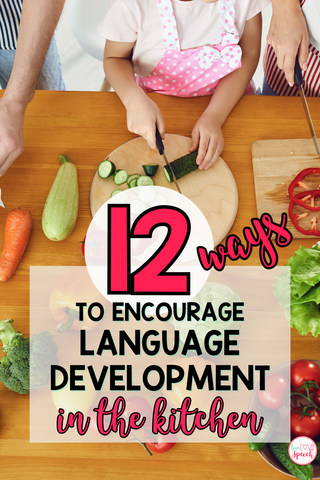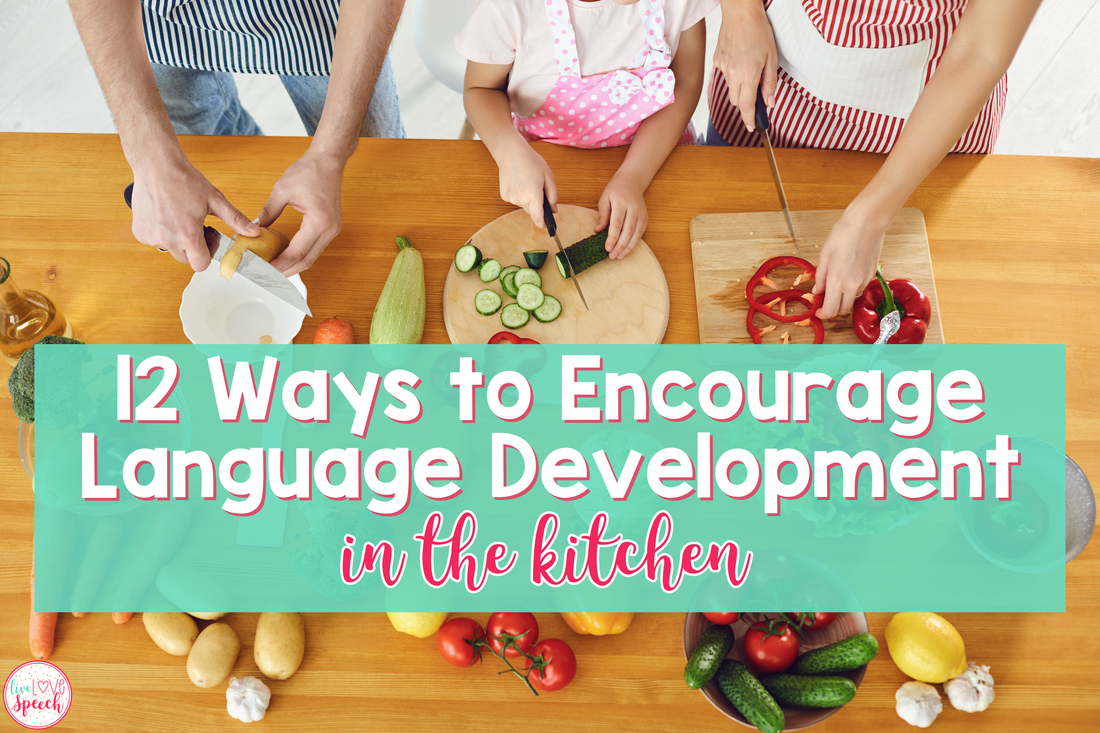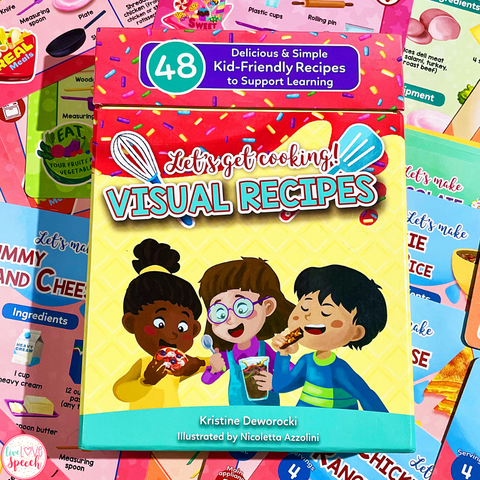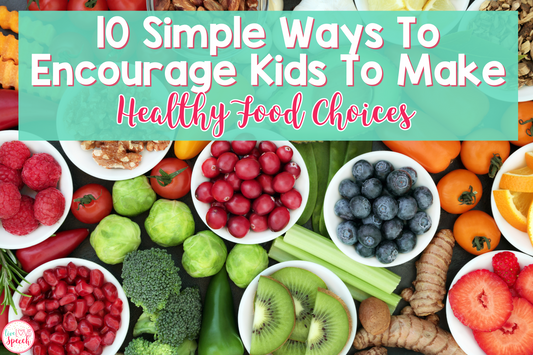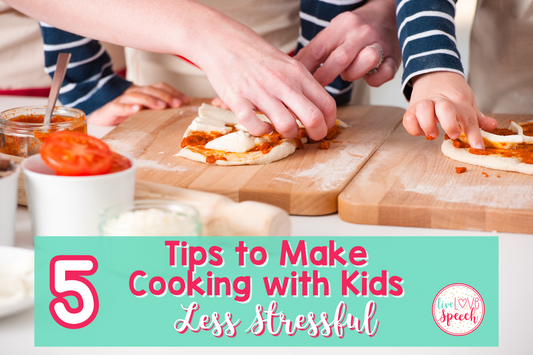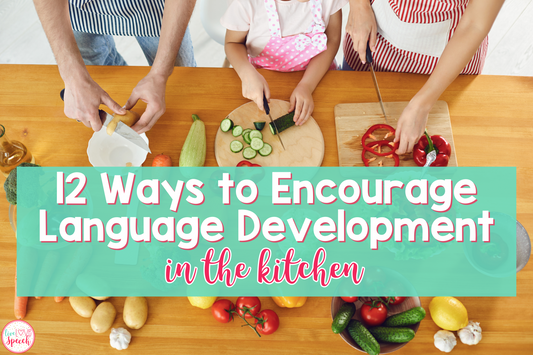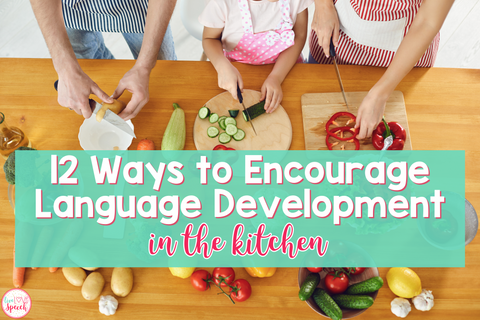
Let's face it—teaching language skills can sometimes feel like a huge challenge.
Everyone learns differently, and "language development" itself is pretty complex. Plus, keeping little ones engaged WHILE working on these skills can be a bit of a juggling act. But who says it has to be mundane? As a speech-language pathologist (SLP) with a love for communication skills and visual recipes, I've got a great solution—bringing language development right into the heart of the home: the kitchen! And guess what? You can encourage this in 12 different ways.
Language Development in the Kitchen
Why language development in the kitchen? Why not!
It can help teach essential skills beyond cooking. Language development, whether through reading, following instructions, or making informed decisions, is integral to the cooking experience. Learning to cook not only equips individuals with valuable culinary skills but also cultivates independence and self-sufficiency in daily tasks.
Honestly, sometimes I feel like I could just teach kids language development solely through cooking!
Tips to Encourage Language Development
1. Recipe Narration:
Selecting simple recipes and encouraging children to narrate the steps as they cook is a fantastic way to foster language development.
As they chop vegetables or mix ingredients, prompt them to describe each action in detail, emphasizing the sequence of steps involved. For instance, they might say, "First, we wash the vegetables, then we chop them into small pieces." This exercise not only strengthens their ability to follow instructions but also enhances their vocabulary and comprehension of sequential concepts.
Additionally, discussing the sensory aspects of cooking, such as the texture of ingredients or the aroma of spices, adds another layer to their descriptive language skills.
By engaging in recipe narration, children not only become confident in the kitchen but also sharpen their communication abilities in a fun and interactive way.

2. Vocabulary Building:
During cooking activities, seize the opportunity to introduce new and relevant vocabulary to children. Concentrate on words associated with ingredients, utensils, and cooking techniques, expanding their vocabulary as they chop, stir, and sauté.
For instance, as they whisk eggs, introduce terms like "whisk," "beat," or "blend," explaining their meanings and demonstrating proper usage. When incorporating ingredients like herbs or spices, discuss their names, flavors, and uses, enriching their understanding of cooking elements.
Similarly, as they engage with various kitchen utensils such as measuring cups, spatulas, or mixing bowls, reinforce vocabulary related to each item's function and purpose.
By integrating vocabulary instruction into cooking activities, children not only enhance their cooking skills but also expand their language proficiency in a practical and engaging manner.
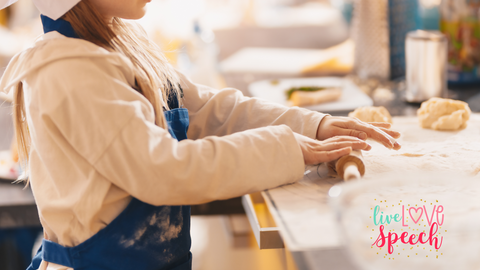
3. Following Directions:
Recipes aren't just about making delicious meals—they're also fantastic for honing in on those all-important listening and following directions skills! Encourage children to pay close attention to each step of the recipe, emphasizing the importance of order and precision in language.
For example, as we read through the recipe together, we can highlight key action words like "mix," "pour," or "stir," ensuring that we understand what needs to be done at each stage. Then, as we put our cooking skills to the test, we can cheer on our kids as they diligently follow each direction, step by step.
Whether it's adding ingredients in the right order or setting the oven to the correct temperature, mastering these directions not only helps us whip up treats but also teaches valuable life skills that extend far beyond the kitchen.
4. Conversation Starters:
Use cooking as a chance for conversation. While you're busy chopping veggies or waiting for the dough to rise, why not chat about your favorite foods, and cooking experiences?

Share stories about your most memorable meals or talk about the special dishes that you love. Discuss your food preferences and any new ingredients you're curious to try. You could also talk about future recipes that they might want to try. I have Visual Recipes to help with this! A monthly bundle with recipes for all year long, check them out here!
By opening up these conversations, you're not only enhancing your expressive and receptive language skills but also building stronger connections and creating cherished memories together in the kitchen.
5. Describing and Comparing:
Encourage children to describe the sensory aspects of cooking, such as textures, smells, and tastes. Compare different ingredients and discuss their attributes.
For example, they can talk about the smoothness of melted chocolate versus the graininess of sugar, the aroma of freshly ground coffee compared to the fragrance of baking bread, or the sweet taste of ripe strawberries versus the tartness of lemons.
Additionally, they can explore how ingredients change during cooking, such as observing how butter melts or how dough rises. By engaging in these descriptive and comparative discussions, children will enhance their language skills.
6. Categorization and Sorting:
Incorporate activities that involve categorization and sorting, like sorting vegetables into different bins based on their types or categorizing ingredients based on their use in recipes—like grouping all the spices together or separating wet and dry ingredients.
This not only keeps things organized in the kitchen but also enhances organizational and cognitive language skills.
For example, children can discuss why certain ingredients belong in specific categories or how sorting helps streamline the cooking process. Moreover, they can explore broader concepts such as food groups or cultural cuisines, expanding their understanding of the diverse world of ingredients and cooking techniques.
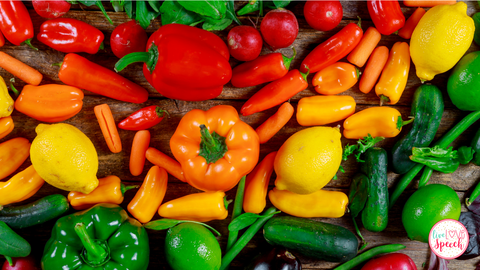
7. Storytelling Through Food:
Create a story using the ingredients or the cooking process as inspiration. Imagine the journey of a carrot from the farm to the kitchen, or the adventures of a pancake flipping in the pan.
By weaving narratives around food, children can explore their creativity and develop narrative language skills in an imaginative way. For instance, they could craft a tale about a potato's quest to become crispy fries, encountering other ingredients along the way who join in the cooking adventure. Alternatively, they might narrate the story of a family recipe passed down through generations, each ingredient carrying with it memories and traditions.
8. Problem-Solving Scenarios:
Introduce simple problem-solving scenarios during cooking to spark critical thinking and communication skills.
For instance, ask questions like, "What do we do if we don't have a particular ingredient?" This prompts children to brainstorm alternative ingredients or creative substitutions, fostering adaptability and resourcefulness in the kitchen.
Another scenario could involve troubleshooting kitchen mishaps, such as a spilled ingredient or a recipe not turning out as expected. By working together to find solutions, children learn to overcome challenges and collaborate effectively.
This step brings up a great question to go over before starting to cook. Cooking Safety! It is important to address cooking safety before starting any meals, or projects! I have a blog post written all about this here, where you can learn 3 Cooking Safety Tips for Kids.
9. Visual Recipe Cards:
Utilizing recipe cards with images for each step of the recipe offers numerous benefits beyond just supporting understanding of temporal concepts and organizing thoughts. Firstly, visual aids appeal to visual learners, making the cooking process more accessible and engaging for individuals who may struggle with text-based instructions alone.
Additionally, visual recipe cards can aid in language development by reinforcing vocabulary associated with cooking utensils, ingredients, and cooking techniques through visual representation. They also promote independence in the kitchen, empowering users to follow recipes confidently without constant supervision.
Moreover, visual recipe cards can be particularly beneficial for individuals with learning differences or cognitive impairments, providing clear and concrete guidance throughout the cooking process.
If you haven't already check out my Visual Recipe Cards, you can find them here!! Plus, check out my blog post written all about Why you should be using Visual Recipes.
10. Speech Sound Practice:
Identify words or phrases with target speech sounds and incorporate them into the cooking process.
For example, if a child is working on the "s" sound, you could focus on words like "stir," "sizzle," or "slice." As they engage in cooking activities, encourage them to repeat these words aloud, emphasizing the target sound.
This provides an opportunity for speech sound practice in a functional context, helping to generalize speech therapy goals beyond structured sessions into real-life situations.
11. Expressing Preferences:
Encourage children to express their likes and dislikes about the food they are preparing. As they engage in cooking activities, ask open-ended questions like, "What do you think about the taste of this sauce?" or "Do you prefer crunchy or soft textures in your vegetables?"
This prompts children to articulate their preferences and opinions, fostering opinion-based language skills.
Additionally, encourage them to explain the reasons behind their preferences, such as citing flavor preferences or texture preferences. This not only strengthens their ability to express opinions but also encourages critical thinking and reflection on personal tastes.

12. Building Social Skills:
Cooking often involves collaboration, making it an ideal setting to teach and practice essential social skills such as taking turns, sharing, and cooperating in a group.
Encourage children to work together as a team, assigning different tasks and roles to each participant.
For example, one child can measure ingredients while another stirs the mixture, fostering a sense of teamwork and shared responsibility. Additionally, emphasize the importance of effective communication and active listening during cooking activities, encouraging children to express their ideas and listen to their peers' suggestions.
This not only promotes collaboration but also enhances communication skills vital for successful social interactions. Furthermore, use cooking challenges or group projects to provide opportunities for problem-solving and conflict resolution, teaching children how to navigate disagreements and reach consensus in a respectful manner.
I hope these ideas add a splash of language development to your next cooking session with your kids. Remember, you can use them anytime, whether you're at home in the kitchen or in the classroom. Let's make language fun with your kids and enjoy the learning process together!
SAVE THIS POST OR SHARE WITH YOUR BESTIE!
Pin this post for practical ways to encourage language development!
